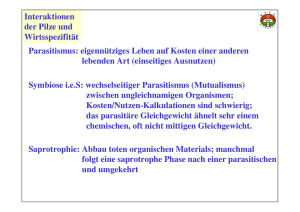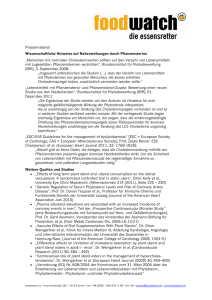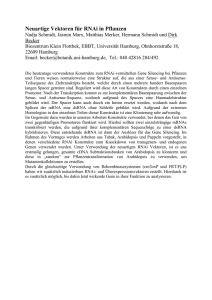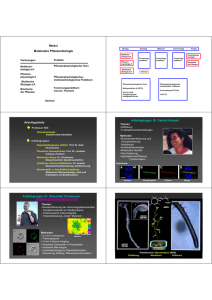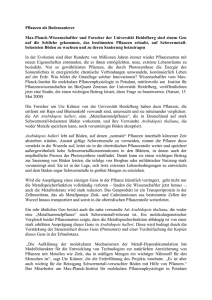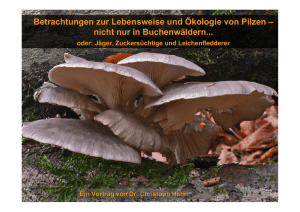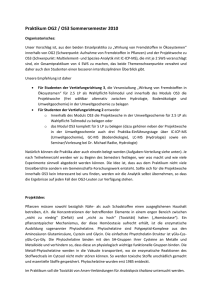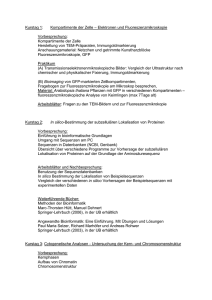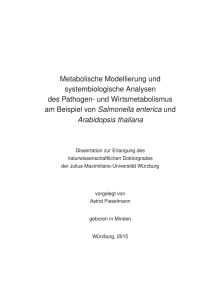als PDF-Datei
Werbung
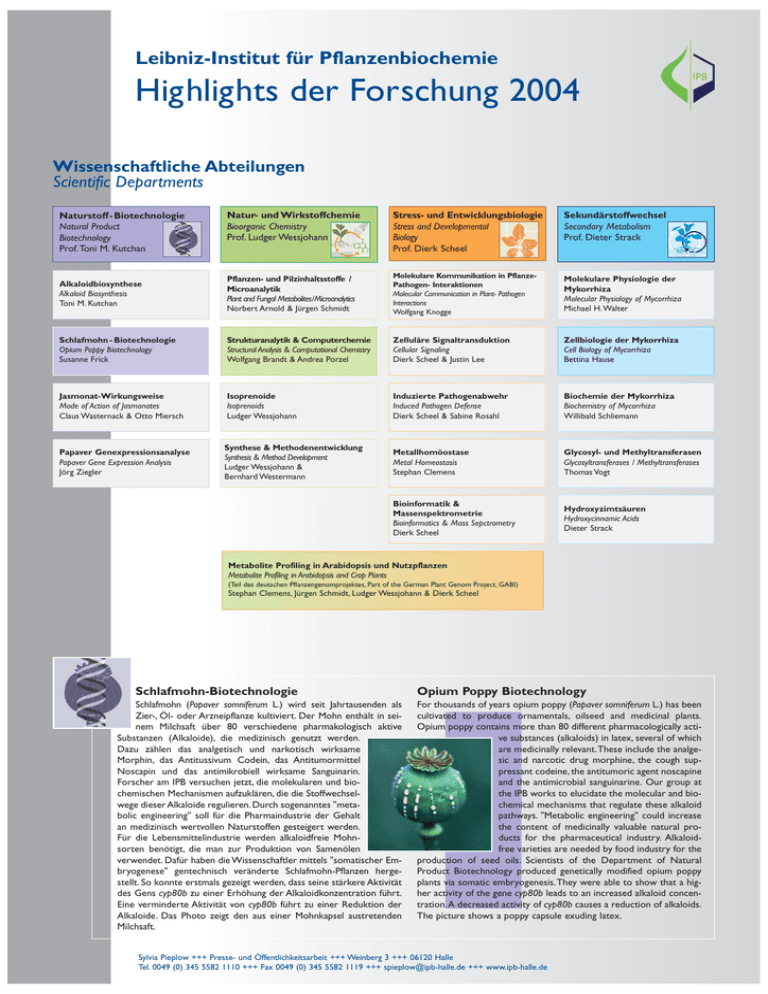
Leibniz-Institut für Pflanzenbiochemie Highlights der Forschung 2004 Wissenschaftliche Abteilungen Scientific Departments Natur- und Wirkstoffchemie Bioorganic Chemistry Prof. Ludger Wessjohann Stress- und Entwicklungsbiologie Stress and Developmental Biology Prof. Dierk Scheel Sekundärstoffwechsel Secondary Metabolism Prof. Dieter Strack Alkaloidbiosynthese Alkaloid Biosynthesis Toni M. Kutchan Pflanzen- und Pilzinhaltsstoffe / Microanalytik Plant and Fungal Metabolites/Microanalytics Norbert Arnold & Jürgen Schmidt Molekulare Kommunikation in PflanzePathogen- Interaktionen Molecular Communication in Plant- Pathogen Interactions Wolfgang Knogge Molekulare Physiologie der Mykorrhiza Molecular Physiology of Mycorrhiza Michael H.Walter Schlafmohn - Biotechnologie Opium Poppy Biotechnology Susanne Frick Strukturanalytik & Computerchemie Structural Analysis & Computational Chemistry Wolfgang Brandt & Andrea Porzel Zelluläre Signaltransduktion Cellular Signaling Dierk Scheel & Justin Lee Zellbiologie der Mykorrhiza Cell Biology of Mycorrhiza Bettina Hause Jasmonat-Wirkungsweise Mode of Action of Jasmonates Claus Wasternack & Otto Miersch Isoprenoide Isoprenoids Ludger Wessjohann Induzierte Pathogenabwehr Induced Pathogen Defense Dierk Scheel & Sabine Rosahl Biochemie der Mykorrhiza Biochemistry of Mycorrhiza Willibald Schliemann Papaver Genexpressionsanalyse Papaver Gene Expression Analysis Jörg Ziegler Synthese & Methodenentwicklung Synthesis & Method Development Ludger Wessjohann & Bernhard Westermann Metallhomöostase Metal Homeostasis Stephan Clemens Glycosyl- und Methyltransferasen Glycosyltransferases / Methyltransferases Thomas Vogt Bioinformatik & Massenspektrometrie Bioinformatics & Mass Sepctrometry Dierk Scheel Hydroxyzimtsäuren Hydroxycinnamic Acids Dieter Strack Naturstoff - Biotechnologie Natural Product Biotechnology Prof.Toni M. Kutchan Metabolite Profiling in Arabidopsis und Nutzpflanzen Metabolite Profiling in Arabidopsis and Crop Plants (Teil des deutschen Pflanzengenomprojektes, Part of the German Plant Genom Project, GABI) Stephan Clemens, Jürgen Schmidt, Ludger Wessjohann & Dierk Scheel Schlafmohn-Biotechnologie Schlafmohn (Papaver somniferum L.) wird seit Jahrtausenden als Zier-, Öl- oder Arzneipflanze kultiviert. Der Mohn enthält in seinem Milchsaft über 80 verschiedene pharmakologisch aktive Substanzen (Alkaloide), die medizinisch genutzt werden. Dazu zählen das analgetisch und narkotisch wirksame Morphin, das Antitussivum Codein, das Antitumormittel Noscapin und das antimikrobiell wirksame Sanguinarin. Forscher am IPB versuchen jetzt, die molekularen und biochemischen Mechanismen aufzuklären, die die Stoffwechselwege dieser Alkaloide regulieren. Durch sogenanntes "metabolic engineering" soll für die Pharmaindustrie der Gehalt an medizinisch wertvollen Naturstoffen gesteigert werden. Für die Lebensmittelindustrie werden alkaloidfreie Mohnsorten benötigt, die man zur Produktion von Samenölen verwendet. Dafür haben die Wissenschaftler mittels "somatischer Embryogenese" gentechnisch veränderte Schlafmohn-Pflanzen hergestellt. So konnte erstmals gezeigt werden, dass seine stärkere Aktivität des Gens cyp80b zu einer Erhöhung der Alkaloidkonzentration führt. Eine verminderte Aktivität von cyp80b führt zu einer Reduktion der Alkaloide. Das Photo zeigt den aus einer Mohnkapsel austretenden Milchsaft. Opium Poppy Biotechnology For thousands of years opium poppy (Papaver somniferum L.) has been cultivated to produce ornamentals, oilseed and medicinal plants. Opium poppy contains more than 80 different pharmacologically active substances (alkaloids) in latex, several of which are medicinally relevant.These include the analgesic and narcotic drug morphine, the cough suppressant codeine, the antitumoric agent noscapine and the antimicrobial sanguinarine. Our group at the IPB works to elucidate the molecular and biochemical mechanisms that regulate these alkaloid pathways. "Metabolic engineering" could increase the content of medicinally valuable natural products for the pharmaceutical industry. Alkaloidfree varieties are needed by food industry for the production of seed oils. Scientists of the Department of Natural Product Biotechnology produced genetically modified opium poppy plants via somatic embryogenesis.They were able to show that a higher activity of the gene cyp80b leads to an increased alkaloid concentration.A decreased activity of cyp80b causes a reduction of alkaloids. The picture shows a poppy capsule exuding latex. Sylvia Pieplow +++ Presse- und Öffentlichkeitsarbeit +++ Weinberg 3 +++ 06120 Halle Tel. 0049 (0) 345 5582 1110 +++ Fax 0049 (0) 345 5582 1119 +++ [email protected] +++ www.ipb-halle.de Leibniz Institute of Plant Biochemistry Research Highlights 2004 Strukturanalytik & Computerchemie Structural Analysis & Computational Chemistry Selenoproteine enthalten das Spurenelement Selen in Form der ungewöhnlichen Aminosäure Selenocystein. Diese Proteine sind physiologisch äußerst wichtig z. B. für die Spermienreifung oder die Synthese von Schilddrüsenhormon. Die Selenoproteine der Thioredoxinreduktasen spielen bei rheumatischer Arthritis oder AIDS eine wichtige Rolle. Die Entwicklung neuer, spezifischer Inhibitoren und damit neuer Wirkstoffe gegen diese Krankheiten setzt die Kenntnis der räumlichen Struktur und des Katalysemechanismus der menschlichen Thioredoxinreduktasen voraus. Mittels Homologiemodelling von Proteinen konnten wir erstmals eine dreidimensionale Struktur der menschlichen Thioredoxinreduktase entwikkeln. Auf der Basis dieser Struktur wurde ein neuer Typ der Enzymkatalyse entdeckt, eine katalytische Triade aus den Aminosäuren Selenocystein (Sec), Histidin und Glutamat. Die Ergebnisse aufwändiger ab initio quantenmechanischer Berechnungen führten zu neuen Einblicken in den detaillierten molekularen Mechanismus und erklären erstmals die spezielle Rolle des Selens. Das Bild zeigt die Struktur der katalytischen Triade, Sec-His-Glu, zusammen mit einem Teil des Liganden Thioredoxin mit S-S-Brücke, welche durch das Enzym reduziert wird. Selenoproteins are responsible for many important physiological processes, such as maturation of sperm, synthesis of thyroid hormones, or production of antioxidative substances.They contain the trace element Selenium in form of the rare amino acid selenocystein (Sec). Thioredoxin reductases are selenoproteins involved in the manifestation of rheumatoid arthritis and aids.The development of specific inhibitors can help to elucidate its function in humans as well as in other organisms. This requires the knowledge of the structure and catalysis mechanism. Based on homology modelling methods we were able to develop the three-dimensional structure of human thioredoxin reductase. Based on this structure and extensive quantum mechanical ab initio calculations we discovered a probable new mechanism of enzyme catalysis, a catalytic triad consisting of selenocystein (Sec), histidine and glutamic acid. For the first time, detailed information about the specific role of selenium in comparison to sulfur analogues could be obtained. The figure shows details of the catalytic triad, Sec-His-Glu, and a part of the disulfide ligand bound to thioredoxin reductase.The S-S bridge of the ligand will be reduced by the enzyme. Metabolite Profiling in Arabidopsis und Metabolite Profiling in Arabidopsis and Crop Plants Nutzpflanzen Die meisten der von Pflanzen gebildeten Stoffe sind noch nicht bekannt und wir wissen wenig über ihre Funktion und die Dynamik ihrer Synthese. Es ist jedoch von allergrößtem Interesse sowohl für das Verständnis des pflanzlichen Stoffwechsels als auch für die Sicherung und Verbesserung der Nahrungsqualität, ein möglichst umfassendes Bild der von einer Pflanze gebildeten Substanzen zu haben. Für das "Metabolite Profiling", die simultane Detektion, Quantifizierung und auch Identifizierung von möglichst vielen Metaboliten des pflanzlichen Stoffwechsels, machen wir uns das Potenzial von modernen Hochleistungsmassenspektrometern nutzbar. In der Modellpflanze Arabidopsis thaliana (siehe Bild) z.B. lassen sich nach derzeitigem Stand etwa 2000 Massensignale auflösen. Kleine Unterschiede im Stoffwechsel zwischen zwei Linien einer Pflanzenart sind damit ebenso aufzuspüren wie Veränderungen, die in der Pflanze als Reaktion auf wechselnde Umweltbedingungen auftreten. Die Entwicklung von Werkzeugen für die Datenverarbeitung ermöglicht uns die Analyse und den Vergleich von vielen Proben. Grundsätzlich sind die entwickelten Techniken auf jedes andere biologische System übertragbar. It is of paramount importance for the understanding of plant biology as well as for improving food security and food quality to be able to closely monitor plant metabolism. However, a large number of plant metabolites are not characterized yet and we know very little about the dynamics of their synthesis and accumulation.The concept of metabolomics (or metabolite profiling) has been developed in recent years to tackle this problem.We are using the potential of state-of-the-art mass spectrometry (capillary LC coupled to electrospray ionization quadrupole time-of-flight MS) for the simultaneous detection, quantification and identification of as many plant metabolites as possible. Currently we are resolving about 2000 mass signals in extracts of the model plant Arabidopsis thaliana (see picture). Bioinformatics tools allow us to process and analyze large data sets. Thus, we are now able to detect small metabolic differences between genetically nearly identical plant lines or to monitor metabolic changes elicited by environmental stimuli. This approach is not restricted to Arabidopsis thaliana but transferable to other biological systems. Zellbiologie der Mykorrhiza Über 80 % der Landpflanzen besitzen die Fähigkeit, mit Pilzen der Ordnung Glomeromycota eine symbiontische Interaktion, die arbuskuläre Mykorrhiza, einzugehen. Der Pilz besiedelt den Cortex der Pflanzenwurzel und bildet dort hoch differenzierte Strukturen aus, die sogenannten Arbuskeln. Äußere Hyphen des Pilzes bilden die Verbindung zwischen Boden und Pflanze und gewährleisten eine verbesserte Aufnahme von Nährstoffen; die Pflanze stellt ihrerseits Saccharose für den Pilz zur Verfügung. Da der Pilz vorrangig Glucose aufnimmt, muss die pflanzliche Saccharose zunächst in Glukose umgewandelt werden. Diese Umwandlung (Hydrolyse) wird durch spezifische Enzyme, den Invertasen, katalysiert. Die Bereitstellung von Saccharose und deren Hydrolyse ist deshalb ein essentieller Faktor für die Interaktion. Unsere AG analysiert die Rolle der Invertasen bei der Ausbildung der Symbiose. Dabei soll der Einfluss der veränderten Zuckerbereitstellung auf die Etablierung der Symbiose untersucht werden. Das Bild zeigt einen Teil des Querschnitts einer mykorrhizierten Tomaten-Wurzel, in dem Invertase-Aktivität innerhalb der arbuskelhaltigen Zellen (Pfeil) mittels einer spezifischen Farbreaktion nachgewiesen wurde. Cell Biology of Mycorrhiza The roots of most plants are able to get engaged in a symbiotic interaction with fungi of the order Glomeromycota. This interaction - the arbuscular mycorrhiza (AM) - is the most widespread form of mycorrhizas on earth. The fungus penetrates the root surface colonizing the intercellular space of root cortex.Tree-like fungal structures, called arbuscules, are formed within individual root cortical cells.The main benefit for the symbiotic partners is the exchange of nutrients: Mineral nutrients are supplied to the plant by the fungus and carbohydrates for the fungus are provided by the plant.The fungus can taken up mainly hexoses. Hence, sucrose released by root cortex cells has to be converted into hexoses by acid invertases.The supply of sucrose and its hydrolysis by invertases is therefore an essential factor for the symbiosis.The work done in our group is focused on the study of the role of invertases in the mycorrhizal interaction. The picture shows a cross section through a mycorrhizal root of tomato.The section was stained by an invertase activity stain and exhibits label in the arbusculated cell (arrow). To analyse the importance of carbohydrate supply on the establishment of AM, plants with modulated carbohydrate metabolism within the roots are used. Sylvia Pieplow +++ Presse- und Öffentlichkeitsarbeit +++ Weinberg 3 +++ 06120 Halle Tel. 0049 (0) 345 5582 1110 +++ Fax 0049 (0) 345 5582 1119 +++ [email protected] +++ www.ipb-halle.de
